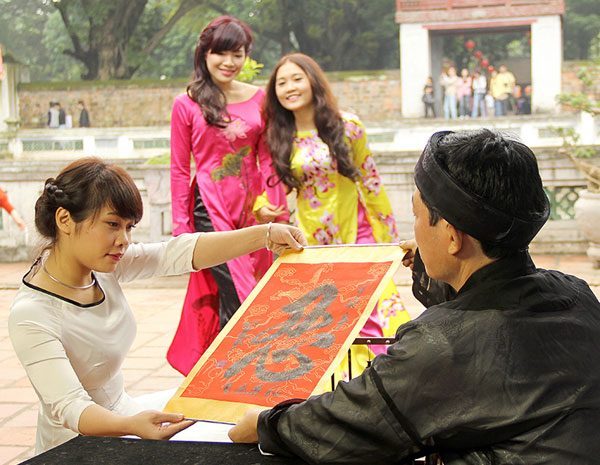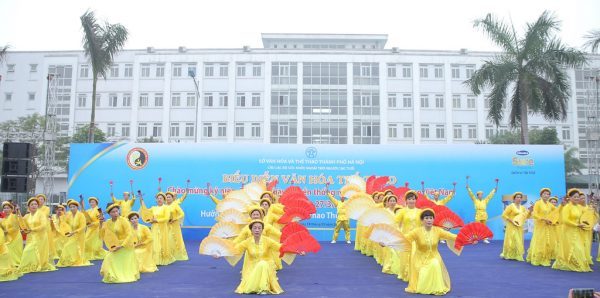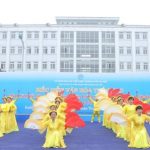Hanoi’s results of cultural families, villages and residential groups building have created a shift in the people’s perception on the role of culture in socio-economic development, the people’s constantly improving lives, and consolidated facilities and cultural institutions.
Promoting strengths of traditional culture
Over 15 years of implementing the “All people join hands to build a cultural life” movement, Hanoi, one of the first localities to response and follow the movement, has so far gained lots of positive results.
In particular, improving the quality of cultural family building has always been a top priority. The percentage of households receiving the title “cultural family” of the city is more than 85% annually (of the total households). In 2016, 86% of households achieved the title “Cultural Family”.

The system of “family culture” clubs in all districts and towns has been maintained in various forms of activities. Many activities honouring typical cultural families has been focused, especially on the anniversaries such as Vietnamese Family Day 28/6; International Happiness Day 20/3, etc. This shows that cultural families always inherit and promote the valuable strengths of the traditional culture of Vietnamese families.
The movement of building “Cultural Villages” and “Cultural Residential Groups” is also important in building new rural areas in the suburbs of Hanoi. Besides quality assurance in registration, inspection, evaluation and recognition, awarding and receiving titles in localities took place solemnly and became the cultural festivals of the hamlets and villages recognized, encouraging villagers to maintain and promote their achievements and at the same time setting up the target for other villages to strive for.

Leading the movement was Thanh Oai district awarding VND 30 million to the initially recognized cultural -village, and VND 20 million to the second-time recognized cultural units and villages; followed by Ung Hoa District with VND 20 million to hamlets recognized as cultural villages. Districts and towns all gave VND 5-15 million to villages that won the title of Cultural Villages.
In 15 years of implementation, the movement to building cultural villages has got remarkable results. In 2002, the whole city had 102 over 640 (about 16%) recognized cultural villages. By 2016, there were 1,401 cultural villages in a total of 2,523 villages (about 55%).
Along with the movement of building “Cultural Villages”, striving for the title “Cultural Residential Groups” is one of the important contents to implement the “All people join hands to build a cultural life” movement. Substantive and effective cultural models specific to localities and units have been promoting. The evaluation and recognition must basically be based on criteria from the cultural residential groups and ensure the order and procedures for registration, evaluation recognition. By 2016, Hanoi had 3,788 in 5,422 residential groups recognized as “Cultural Residential Groups”, reaching 70%.
Building a civilized lifestyle in weddings and funerals
Weddings are held according to the “Formal-Joyful-Healthy-Saving” orientation supported by the majority of people, limiting negative phenomena in the weddings. However, it is actually difficult to comply with such regulations for many reasons, such as customs, family relationships, influences of siblings, relatives, colleagues, and other social impacts.
In the past few years, the wedding conventions have been step by step contributing to the health of the wedding organization in different places, especially in the suburbs of Hanoi where remarkable progress has been made. Most of the weddings have not used tobacco, have been held in one day rather than for many days together with widespread parties. Meanwhile, in the inner city and among cadres, workers and officials, there observes a slow shift. By 2015, the city had 46,993 in 50,592 weddings following the cultural lifestyle (92.8%).
In the organization of the funerals, since the conventions, regulations on the organization of funerals in most respects have met the “solemn-saving-sentimental” spirit, the villages, hamlets, and residential groups have established funeral organizing committee with the procedures and rituals in accordance with the spirit of the local conventions, which is less expensive and expresses the concern and mutual help among members in the community in difficulties. Cumbersome, long-lasting and widespread eating funerals have not been seen. Unsound funeral customs (rolling on road, hired crying, playing gambling, etc.) have almost disappeared. Up to now, most districts and towns have not only encouraged but also issued positive supportive policies for households who accept cremation with high rates.
Dong Anh District has been at the forefront of this activity by building and implementing the project on implementing the civilized funerals in Dong Anh district in the 2008-2011 period with 4 contents and 6 solutions: No eating treats in funerals, 49-day offerings and burial; abolishment of unsound customs; cemetery planning; cremation promotion (the district supports VND 3 million/case).
Consolidating the system of grassroots cultural and sports institutions
At present, Hanoi has 24 cultural and sports institutions under the city’s management; 29 in 30 districts and towns having cultural and sports institutions in service of local political activities and cultural and spiritual activities of the people; At the communal level, there are 105 in 584 communes having community centers and 236 communes and wards having libraries. The remaining 386 communes are in the process of building new rural areas with planned cultural and sports centres, etc.
The cultural and sports institutions in the area have gradually been innovated in terms of organization and operation methods, with improved facilities. A number of cultural and sports centres have been built and operated effectively, serving the needs of the people. 201 in 386 communes have been recognized as standard new rural areas, all of which have the systems of hamlet community centres and sports areas substantially meeting the prescribed criteria.
Hanoi city’s active building of a cultural life is evidence for the satisfaction of grassroots cultural activity organization and management to people’s aspirations, making culture penetrate deeply into each family and community, creating a profound change and becoming a measure of the quality of life, the development of human personality, beauty in each family, clan and community.
Gia Huy

